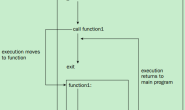C++实现超赞的解魔方的机器人代码,这段代码精简实用,作者的脑子不知道是怎么长的,厉害。
/**********************************************************************
*
* A cube 'state' is a vector<int> with 40 entries, the first 20
* are a permutation of {0,...,19} and describe which cubie is at
* a certain position (regarding the input ordering). The first
* twelve are for edges, the last eight for corners.
*
* The last 20 entries are for the orientations, each describing
* how often the cubie at a certain position has been turned
* counterclockwise away from the correct orientation. Again the
* first twelve are edges, the last eight are corners. The values
* are 0 or 1 for edges and 0, 1 or 2 for corners.
*
* http://www.75271.com
**********************************************************************/
#include <iostream>
#include <string>
#include <vector>
#include <map>
#include <queue>
#include <algorithm>
using namespace std;
//----------------------------------------------------------------------
typedef vector<int> vi;
//----------------------------------------------------------------------
int applicableMoves[] = { 0, 262143, 259263, 74943, 74898 };
// TODO: Encode as strings, e.g. for U use "ABCDABCD"
int affectedCubies[][8] = {
{ 0, 1, 2, 3, 0, 1, 2, 3 }, // U
{ 4, 7, 6, 5, 4, 5, 6, 7 }, // D
{ 0, 9, 4, 8, 0, 3, 5, 4 }, // F
{ 2, 10, 6, 11, 2, 1, 7, 6 }, // B
{ 3, 11, 7, 9, 3, 2, 6, 5 }, // L
{ 1, 8, 5, 10, 1, 0, 4, 7 }, // R
};
vi applyMove ( int move, vi state ) {
int turns = move % 3 + 1;
int face = move / 3;
while( turns-- ){
vi oldState = state;
for( int i=0; i<8; i++ ){
int isCorner = i > 3;
int target = affectedCubies[face][i] + isCorner*12;
int killer = affectedCubies[face][(i&3)==3 ? i-3 : i+1] + isCorner*12;;
int orientationDelta = (i<4) ? (face>1 && face<4) : (face<2) ? 0 : 2 - (i&1);
state[target] = oldState[killer];
//state[target+20] = (oldState[killer+20] + orientationDelta) % (2 + isCorner);
state[target+20] = oldState[killer+20] + orientationDelta;
if( !turns )
state[target+20] %= 2 + isCorner;
}
}
return state;
}
int inverse ( int move ) {
return move + 2 - 2 * (move % 3);
}
//----------------------------------------------------------------------
int phase;
//----------------------------------------------------------------------
vi id ( vi state ) {
//--- Phase 1: Edge orientations.
if( phase < 2 )
return vi( state.begin() + 20, state.begin() + 32 );
//-- Phase 2: Corner orientations, E slice edges.
if( phase < 3 ){
vi result( state.begin() + 31, state.begin() + 40 );
for( int e=0; e<12; e++ )
result[0] |= (state[e] / 8) << e;
return result;
}
//--- Phase 3: Edge slices M and S, corner tetrads, overall parity.
if( phase < 4 ){
vi result( 3 );
for( int e=0; e<12; e++ )
result[0] |= ((state[e] > 7) ? 2 : (state[e] & 1)) << (2*e);
for( int c=0; c<8; c++ )
result[1] |= ((state[c+12]-12) & 5) << (3*c);
for( int i=12; i<20; i++ )
for( int j=i+1; j<20; j++ )
result[2] ^= state[i] > state[j];
return result;
}
//--- Phase 4: The rest.
return state;
}
//----------------------------------------------------------------------
int main ( int argc, char** argv ) {
//--- Define the goal.
string goal[] = { "UF", "UR", "UB", "UL", "DF", "DR", "DB", "DL", "FR", "FL", "BR", "BL",
"UFR", "URB", "UBL", "ULF", "DRF", "DFL", "DLB", "DBR" };
//--- Prepare current (start) and goal state.
vi currentState( 40 ), goalState( 40 );
for( int i=0; i<20; i++ ){
//--- Goal state.
goalState[i] = i;
//--- Current (start) state.
string cubie = argv[i+1];
while( (currentState[i] = find( goal, goal+20, cubie ) - goal) == 20){
cubie = cubie.substr( 1 ) + cubie[0];
currentState[i+20]++;
}
}
//--- Dance the funky Thistlethwaite...
while( ++phase < 5 ){
//--- Compute ids for current and goal state, skip phase if equal.
vi currentId = id( currentState ), goalId = id( goalState );
if( currentId == goalId )
continue;
//--- Initialize the BFS queue.
queue<vi> q;
q.push( currentState );
q.push( goalState );
//--- Initialize the BFS tables.
map<vi,vi> predecessor;
map<vi,int> direction, lastMove;
direction[ currentId ] = 1;
direction[ goalId ] = 2;
//--- Dance the funky bidirectional BFS...
while( 1 ){
//--- Get state from queue, compute its ID and get its direction.
vi oldState = q.front();
q.pop();
vi oldId = id( oldState );
int& oldDir = direction[oldId];
//--- Apply all applicable moves to it and handle the new state.
for( int move=0; move<18; move++ ){
if( applicableMoves[phase] & (1 << move) ){
//--- Apply the move.
vi newState = applyMove( move, oldState );
vi newId = id( newState );
int& newDir = direction[newId];
//--- Have we seen this state (id) from the other direction already?
//--- I.e. have we found a connection?
if( newDir && newDir != oldDir ){
//--- Make oldId represent the forwards and newId the backwards search state.
if( oldDir > 1 ){
swap( newId, oldId );
move = inverse( move );
}
//--- Reconstruct the connecting algorithm.
vi algorithm( 1, move );
while( oldId != currentId ){
algorithm.insert( algorithm.begin(), lastMove[ oldId ] );
oldId = predecessor[ oldId ];
}
while( newId != goalId ){
algorithm.push_back( inverse( lastMove[ newId ] ));
newId = predecessor[ newId ];
}
//--- Print and apply the algorithm.
for( int i=0; i<(int)algorithm.size(); i++ ){
cout << "UDFBLR"[algorithm[i]/3] << algorithm[i]%3+1;
currentState = applyMove( algorithm[i], currentState );
}
//--- Jump to the next phase.
goto nextPhasePlease;
}
//--- If we've never seen this state (id) before, visit it.
if( ! newDir ){
q.push( newState );
newDir = oldDir;
lastMove[ newId ] = move;
predecessor[ newId ] = oldId;
}
}
}
}
nextPhasePlease:
;
}
}




